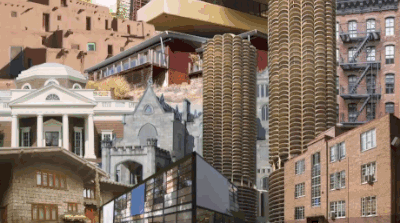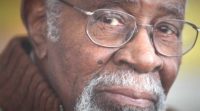When architect Eero Saarinen died suddenly in 1961, some of his most important work was still under construction. The TWA Flight Center, Dulles International Airport, and the Gateway Arch were all incomplete— not unlike the truncated relationship he had with his son, Eric. More than 50 years later, Eero’s buildings are monuments to his brilliance and creative foresight. But for Eric, they’re different kinds of reminders: of an absent father, a man who left his family for another woman, and for his work.
That emotional thicket of appreciation and resentment, of celebration and pain, is at the heart of the documentary Eero Saarinen: The Architect Who Saw the Future, which will air on PBS December 27. Directed by Peter Rosen, with cinematography by Eric Saarinen, it’s an ambitious film that attempts more than its one-hour running time can handle. But by introducing Eero’s buildings through Eric’s exploration of them, we engage with the architecture on a human rather than a purely conceptual level.
The documentary is mainly a profile of Eero Saarinen, born in 1910 in Finland. His father, Eliel Saarinen, emigrated to the U.S., founded his own practice, and became the architect and president of Cranbrook Academy of Art in Bloomfield Hills, Michigan. Eero joined Eliel’s firm in 1936, bested him in 1948 by winning the St. Louis Jefferson Memorial competition with his design for the Gateway Arch, then took over the business when Eliel died in 1950. This began a torridly productive 11-year period: the General Motors Technical Center, the TWA Flight Center, Ingalls Rink at Yale, the Miller House, North Christian Church. Eero had become one of the world’s preeminent Modernist architects, and then suddenly died after surgery for a brain tumor.
In all, the film covers 11 projects, and his furniture line with Knoll, at a breakneck pace that necessarily gives us surface-level examinations of the work. But this is mitigated by interviews with associates like designer Niels Diffrient and architect Kevin Roche, whose own career took off by completing the CBS Building, among others, after Saarinen’s death. They add a level of intimacy to Saarinen’s work that elevates the building tour above simple cataloguing, as do insights about the work and life by architect Robert A.M. Stern, biographer Jayne Merkel, and RECORD editor in chief Cathleen McGuigan.
But, still, the core of the film is Eric’s search for closure with his father. He felt abandoned when his father left him, his sister, and mother in 1954 to marry journalist Aline Louchheim, with whom he’d been having an affair. But the estrangement began even before the affair, as Eero prioritized career over family. He spent little time at home, sacrificing his family for his drafting table and oversized design models. When he died, he left an open emotional wound that Eric found difficult to suture.
The documentary exists as part memoir and part therapy, in the spirit of My Architect (2003), Nathaniel Kahn’s portrait of his father, Louis Kahn. The familial dynamics at play in that film are different from what Eric experienced with Eero, but there is a similar need to understand who this man was and the price those around him paid for his relentless striving.
As Eric explores his father’s buildings, he sees many of them with fresh eyes—not necessarily dispassionately, but critically and appreciatively and often with wonderment. Through him, we experience Eero’s architecture with a similar sense of awe. Through the architecture, Eric solves the crisis at the center of his relationship with his father. “I never saw it from his point of view,” Eric says; “I forgive him for his genius.” It’s an emotional application of a lesson Eliel taught Eero: “Perhaps the most important thing I learned from my father was that any design problem should ‘see’ the solution in terms of the next-largest thing,” Eero says in the film. “A chair in a room, a room in a house, a house in an environment.”
A dysfunctional dynamic between father and son is surely more complex than a design problem. But by fostering this kind of connection across three generations of Saarinens, The Architect Who Saw the Future—despite its compression— taps into a kind of cosmic poetry that’s unexpected, expansive, and beautiful.







Post a comment to this article
Report Abusive Comment